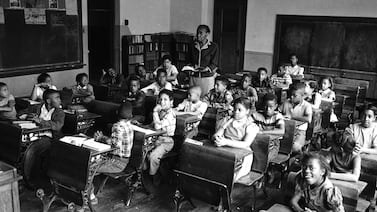Sign up for Chalkbeat New York’s free daily newsletter to keep up with NYC’s public schools.
New York City’s teachers union released an analysis Tuesday that contends hundreds of schools have enough space to meet the requirements of a state class size mandate.
About 856 schools have sufficient classroom space in their buildings to reduce class sizes under new state caps that were passed into law in 2022, the analysis shows. The union estimates that the city would need to hire about 3,000 additional teachers to reduce class sizes at these schools.
The union’s report only looked at the 1,300 city schools that receive federal dollars that support low-income students. Union officials said they focused on those schools because the state’s class size law requires the city to prioritize high-need campuses, though the law will apply to all schools once it is fully phased in. (The city operates about 1,600 public schools.)
Under the law, classes may not exceed 20 students from kindergarten through third grade, 23 students in grades 4-8, and 25 students in high school (physical education and other classes involving performing groups are limited to 40 students). The law phases in gradually with 20% of classrooms per year required to comply with the new caps until all classrooms are covered in 2028.
The United Federation of Teachers was a key player pushing for the stricter class size caps, pointing to research that shows students benefit from smaller classes, though the union has raised concerns about whether the city intends to comply with the law.
“For the schools that we know have the space, it should be much easier to do this — it really is just a question of hiring additional teachers,” Michael Mulgrew, the union’s president, said during a press conference on Tuesday outside the Education Department’s Manhattan headquarters.
But education officials and experts stress that complying with the new mandate will be a challenging and expensive undertaking that involves difficult tradeoffs. About 40% of classrooms already meet the caps, meaning dramatic changes aren’t needed to comply with the law during the first two years of implementation. Things get more complicated after that.
The city will need to ramp up teacher recruitment, spending between $1.3 billion to $1.9 billion annually to hire thousands of additional teachers on top of the 3,000 to 6,000 educators who are typically hired each year, according to projections by the city and the Independent Budget Office.
“Hiring teachers, and especially in this labor market, isn’t always the easiest thing to do,” said Matthew Chingos, an Urban Institute researcher who has studied the impact of the class size law. Schools that are forced to spend more of their budgets on teachers may be constrained in funding for other programs or roles such as deans, aides, or counselors, he added.
Plus, city officials say about 500 campuses do not have enough space for additional classrooms to comply with the new caps, forcing tradeoffs such as capping enrollment or constructing new buildings at a cost city officials say could reach between $22 billion and $27 billion.
Experts have also noted that the law requires directing resources to schools with relatively lower poverty rates because high-need schools are already more likely to already have lower class sizes. Last summer, the state’s education commissioner raised concerns about the law’s equity implications.
Mulgrew acknowledged that implementing the law will get more challenging after next school year, but downplayed the notion that schools may have to cap enrollment or cut programs.
“We don’t want students being turned away, we don’t want you closing programs that work,” Mulgrew said. The union chief also waved away equity concerns about the law. “All children in New York City should benefit from this,” he said.
City Education Department spokesperson Nathaniel Styer said officials “have been in constant engagement” with the unions that represent teachers and principals, which must both sign off on the city’s class size reduction plans.
“The law required that 20 percent of classes meet the class size mandate this year, and we met that requirement,” Styer wrote. “We will continue to stay in compliance with the law.”
Alex Zimmerman is a reporter for Chalkbeat New York, covering NYC public schools. Contact Alex at azimmerman@chalkbeat.org.








